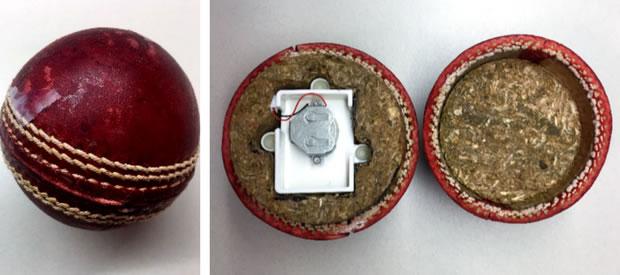
Real-Time Sports Analytics: Sensors in Equipment Enhance Insights

The sensors are wrapped in a protective case and embedded in a cricket ball. They employ inferencing algorithms that can track movement to within a few centimeters, and accurately characterize 3-D ball motion, such as trajectory, orientation, and revolutions per second.
Credit: University of Illinois
In an effort to make big data analytics more accessible for the sports industry, researchers from the University of Illinois at Urbana-Champaign have utilized IoT devices–low-cost sensors and radios–that can be embedded into sports equipment (e.g., balls, rackets, and shoes), as well as in wearable devices.
“There's a lot of interest in analyzing sports data though high-speed cameras, but a system can cost up to $1 million to implement and maintain. It's only accessible to big clubs,” said Mahanth Gowda, a PhD candidate in computer science and lead author of the study, “Bringing IoT to Sports Analytics.” “We want to cut down the expense significantly by replacing cameras with inexpensive internet-of-things devices (costing less than $100 in total) to make it possible for many other organizations to use the technology.”
The team–led by Romit Roy Choudhury, an associate professor of electrical and computer engineering and computer science at Illinois, jointly with Sharon Yang from Intel–has developed advanced motion tracking algorithms from the various incomplete and noisy measurements of inertial measurement unit (IMU) sensors and wireless radios, fitted inside a ball and players' shoes. If the technology gains traction, real-time analytics should be possible at anytime, anywhere.
The tiny sensors, which are wrapped in a protective case and distributed evenly in equipment, employ inferencing algorithms that can track movement to within a few centimeters. They can accurately characterize 3D ball motion, such as trajectory, orientation, and revolutions per second.
“This level of accuracy and accessibility could help players in local clubs read their own performance from their smartphones via Bluetooth, or school coaches could offer quantifiable feedback to their students,” said Roy Choudhury, who is also a research professor at Illinois' Coordinated Science Lab. The feedback could also help with detecting and analyzing player injuries, such as concussions. The sensor inside a soccer ball, for example, can measure how hard it hits a player's head, giving coaches an indication about whether to treat the player for head injury.
“We've truly scratched the surface for applications with these sensors. The algorithms provide extremely fine-grained detail and accuracy in measurements, but use common measuring tools that can be found in any smartphone,” said Gowda.
The paper, to be published in USENIX NSDI 2017, explores tracking the 3D trajectory and spin parameters of a cricket ball; however, the core motion tracking techniques can be generalized to many different sports analytics.
The team, composed of students Ashutosh Dhekne, Sheng Shen, along with other Intel collaborators, have also been developing methods to charge the sensors, including harvesting energy from the spin of the ball.
“We're motivated to develop this technology to help coaches make better decisions on and off the field and provide enhanced entertainment to viewers,” said Roy Choudhury. “We want to bring advanced but affordable sports analytics to everyone, anywhere, anytime.”












